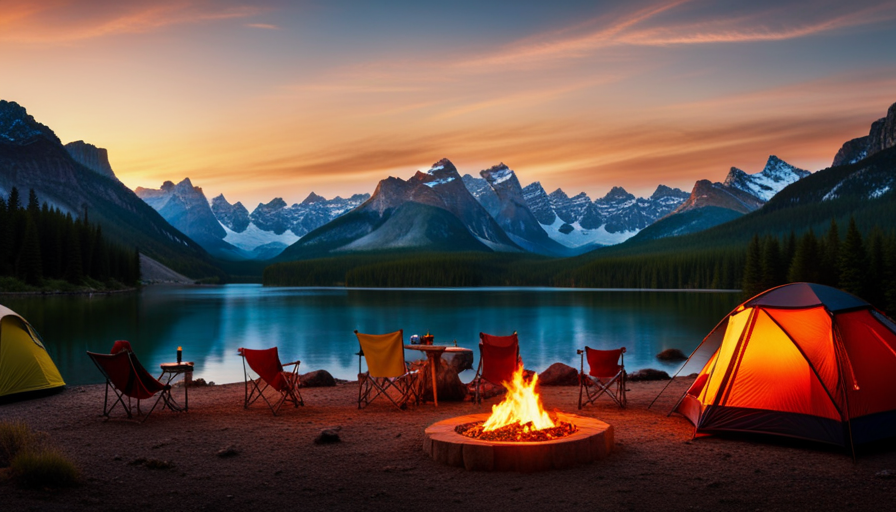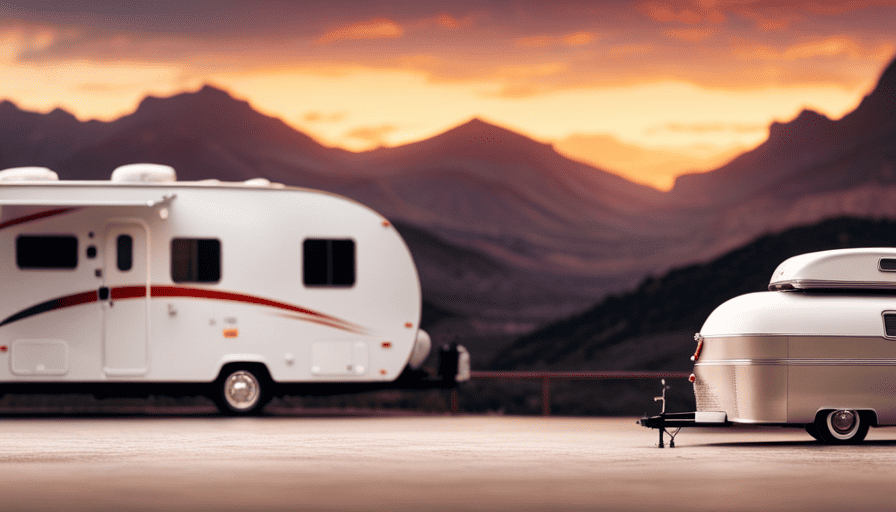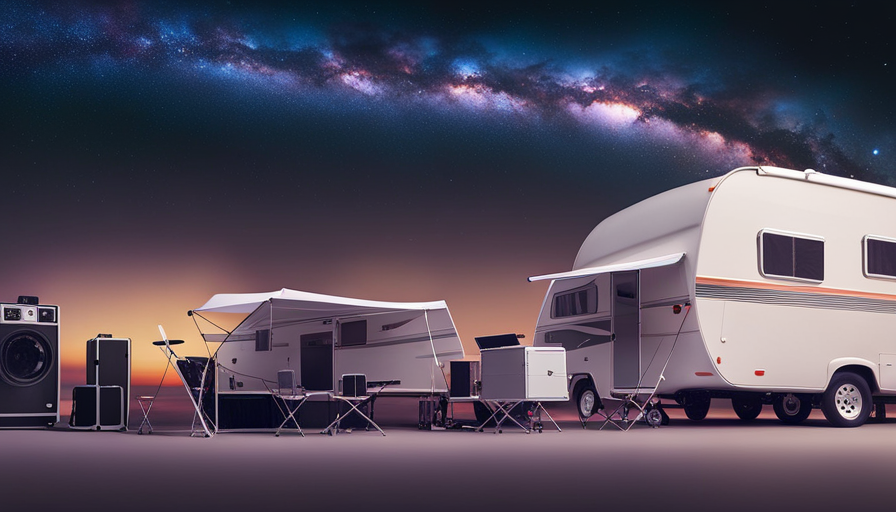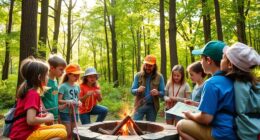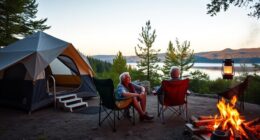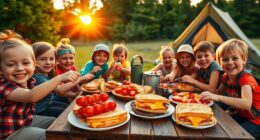Have you ever fantasized about giving your camper shell a new and fresh appearance? You’re in luck because I am going to share with you a secret – the process of painting a camper shell.
It’s a technique that can completely transform the appearance of your camper shell and make it stand out from the rest. Now, I’m not talking about just any old paint job. I’m talking about a professional-grade, showroom-worthy finish that will have heads turning wherever you go.
So, if you’re ready to roll up your sleeves and dive into the world of camper shell painting, then buckle up because I’m about to take you on a step-by-step journey that will have you painting like a pro in no time.
Get ready to unleash your inner artist and give your camper shell the makeover it deserves!
Key Takeaways
- Properly preparing the surface before painting is essential.
- Choosing the right type of paint considering climate and durability is important.
- Applying thin layers of paint and allowing each layer to dry completely is crucial.
- Regular cleaning, waxing, and maintenance practices are necessary for the longevity and durability of the painted surface.
Prepare the Surface
Before you can paint the camper shell, you’ll need to clean and sand the surface to ensure a smooth and even finish. This step is crucial for achieving professional-looking results.
Start by thoroughly cleaning the camper shell with a mild detergent and water solution. Remove any dirt, grease, or wax that may be present on the surface.
Once the shell is clean, it’s time to sand and prime it. Use a fine-grit sandpaper to gently sand the entire surface, creating a rough texture that will help the paint adhere better. Make sure to sand any rough spots or imperfections until they’re smooth.
After sanding, wipe down the surface with a tack cloth to remove any dust or debris.
Next, apply a coat of primer specifically designed for automotive applications. This’ll provide a smooth base for the paint and help it adhere better to the surface. Allow the primer to dry completely before moving on to the next step.
By properly sanding and priming the camper shell, you’re ensuring a solid foundation for the paint to adhere to.
Now that the surface is prepped and ready, it’s time to choose the right paint for your camper shell.
Choose the Right Paint
When choosing the right paint for painting a camper shell, it’s important to consider the type of paint that will work best for your specific needs. Different types of paint have different properties and application methods, so it’s crucial to choose the one that’ll provide the desired finish and durability.
Additionally, selecting the right color is an important decision as it can greatly impact the overall look and feel of the camper shell.
Lastly, don’t forget to purchase all the necessary supplies such as primer, paint brushes or sprayers, masking tape, and sandpaper to ensure a smooth and successful painting process.
Consider the Type of Paint
Choosing the right type of paint for your camper shell will make it shine like a million shooting stars. When considering the type of paint, there are a few important factors to keep in mind.
-
Considerations: Think about the climate and weather conditions your camper shell will be exposed to. Choose a paint that’s durable and can withstand the elements.
-
Preparations: Properly prepare the surface of the camper shell before painting by cleaning it thoroughly and removing any rust or old paint. This’ll ensure that the new paint adheres properly and lasts longer.
-
Quality: Invest in high-quality paint to achieve a professional and long-lasting finish. Cheaper paints may not provide the same level of durability or shine.
-
Application method: Decide whether you want to use spray paint or brush-on paint. Each method has its own advantages and disadvantages, so choose the one that suits your preferences and abilities.
Considering these factors will help you choose the right type of paint for your camper shell. Now, let’s move on to selecting the perfect color.
Select the Color
Now, let’s dive into finding the ideal shade that will transform your camper shell into a vibrant and eye-catching masterpiece. When it comes to choosing the shade for your camper shell, you have a multitude of custom color options to consider. Whether you want to match your vehicle’s existing color or create a unique and personalized look, selecting the right shade is crucial. To help you visualize the possibilities, take a look at the table below showcasing some popular color options:
| Color | Description |
|---|---|
| Classic White | Clean and timeless |
| Bold Red | Striking and energetic |
| Metallic Silver | Sleek and modern |
| Forest Green | Natural and calming |
Consider these options and choose the shade that best reflects your style and desired aesthetic. With the color decided, it’s time to move on to the next step: purchasing the necessary supplies.
Purchase the Necessary Supplies
To get started on your camper shell transformation, it’s time to stock up on all the necessary supplies. Don’t forget to grab everything you need to turn your vision into reality, as they say, ‘a stitch in time saves nine!’
When it comes to painting a camper shell, choosing the right primer is crucial. Look for a high-quality automotive primer that’s compatible with the type of paint you plan to use. This will ensure proper adhesion and a smooth, long-lasting finish. Additionally, here are some tips for achieving a professional finish: make sure to clean and prep the surface thoroughly, apply the primer evenly using a spray gun or roller, and allow sufficient drying time between coats.
Now that you have your primer, let’s move on to the next step: masking and taping.
Masking and Taping
Before diving into the painting process, it’s crucial to master the art of masking and taping for a flawless camper shell finish. This step is essential to ensure that only the desired areas are painted, while protecting other parts from overspray. Proper masking and taping techniques will save you time and effort in the long run, and here are some advantages and tips to help you achieve professional results:
Advantages of masking and taping:
- Prevents paint overspray on unwanted areas.
- Creates clean and sharp lines for a professional finish.
- Protects windows, trim, and other delicate parts from damage.
Here are some tips to make your masking and taping process easier and more effective:
- Use high-quality painter’s tape that adheres well and leaves no residue.
- Clean the surface thoroughly before applying tape to ensure proper adhesion.
- Take your time to carefully mask off each area, ensuring precise coverage.
By mastering the art of masking and taping, you’ll be one step closer to achieving a flawless camper shell paint job. Once you’ve mastered this technique, you can move on to applying the base coat.
Apply the Base Coat
Let’s dive into the exciting process of applying the base coat for a stunning finish on your camper shell project! Applying the base coat requires precision and attention to detail.
First, make sure you’ve properly prepared the surface by cleaning and sanding it. This’ll ensure that the base coat adheres well and provides a smooth finish.
When applying the base coat, use even strokes and maintain a consistent distance from the surface. This’ll prevent uneven coverage and drips. It’s important to apply the paint in thin layers to avoid a heavy, clumpy finish. Allow each layer to dry completely before applying the next one.
The drying process can vary depending on the type of paint you’re using. Some paints may require several hours to dry, while others may dry more quickly. It’s essential to follow the manufacturer’s instructions for drying times and conditions. Keep in mind that humidity and temperature can affect the drying process, so make sure to work in a well-ventilated area with appropriate temperature control.
Once the base coat is dry, you can proceed to add additional coats for a more vibrant and durable finish.
Add Additional Coats
After applying the base coat to the camper shell, it’s time to move on to the next step: adding additional coats. This is an important part of the painting process as it helps to achieve a smooth and even finish.
To begin, make sure that the base coat has had enough drying time. This is crucial to prevent any smudging or smearing of the paint. Once the base coat is dry, grab your spray gun and get ready to apply the additional coats.
Here are the steps to follow:
- Hold the spray gun about 8-12 inches away from the surface of the camper shell.
- Apply a thin and even coat of paint, making sure to cover all areas.
- Allow each coat to dry for the recommended drying time, usually around 10-15 minutes.
- Repeat the process, adding additional coats until you achieve the desired color and coverage.
It’s important to note that after completing the buffing process, the camper shell will need some time to dry before applying the clear coat. This will ensure a smooth and flawless finish.
Now that we’ve applied the additional coats, it’s time to move on to the next step: applying the clear coat.
Apply Clear Coat
Now that we’ve added the additional coats, it’s time to apply the clear coat to give the surface a glossy and protective finish, enhancing the overall appearance of the camper shell. Applying the clear coat is a crucial step in the painting process as it not only adds shine but also acts as a barrier against UV rays, dirt, and other environmental factors that can damage the paint job.
To ensure a professional-looking finish, it’s important to use proper buffing techniques when applying the clear coat. This involves using a high-quality buffer and applying even pressure in circular motions to evenly distribute the clear coat across the surface of the camper shell. It’s important to pay close attention to any areas that may require additional coats or touch-ups.
Clear coat application techniques also require precision and attention to detail. It’s important to apply the clear coat in thin, even layers to avoid drips or uneven coverage. This can be achieved by using a high-quality paint gun or spray can, holding it at a consistent distance from the surface, and moving in a steady, sweeping motion.
Once the clear coat has been applied, it’s time to move on to the next step: removing the masking and tape. This will reveal the crisp lines and edges of the painted camper shell, completing the transformation and giving it a professional-grade finish.
Remove Masking and Tape
Once the clear coat has been applied, it’s time to carefully remove the masking and tape, unveiling the sharp lines and edges of the flawlessly painted surface. This step is crucial to achieve a professional finish and ensure that no paint chips or residue are left behind. Here’s how to do it properly:
-
Start by gently peeling off the tape at a 45-degree angle to prevent any paint from lifting or chipping. Take your time and be patient to avoid any mishaps.
-
Use a plastic razor blade or a soft cloth soaked in rubbing alcohol to remove any adhesive residue left by the tape. Be cautious not to scratch the paint surface.
-
Inspect the entire painted area to ensure that all masking and tape has been removed, paying close attention to any small crevices or intricate details.
Removing residue and preventing paint chipping are essential for achieving a flawless paint job on your camper shell. Once this step is complete, it’s time to move on to the next phase: polishing and waxing the surface to protect and enhance the paint’s shine.
Transitioning into the subsequent section about ‘polish and wax,’ we can now focus on the final touches that will give your camper shell a showroom-worthy appearance.
Polish and Wax
When it comes to polishing and waxing your camper shell, there are three key points to keep in mind. First, buffing the paint is essential to remove any imperfections and create a smooth surface.
Next, applying wax not only adds a protective layer to the paint, but also enhances its shine.
Lastly, achieving a smooth finish requires attention to detail and the use of high-quality products. By following these steps, you can ensure that your camper shell looks its best and is well-protected against the elements.
Buff the Paint
To achieve a smooth and glossy finish, it’s important to buff the paint on the camper shell, even if you’re concerned about the time it may take. Buffing techniques involve using a machine with a rotating pad to remove imperfections and enhance the shine of the paint.
Here are three sub-lists to help you understand the process better:
-
Start by choosing the right polishing compound based on the condition of the paint. Coarser compounds are ideal for removing scratches and oxidation, while finer compounds work well for minor imperfections.
-
Apply a small amount of compound onto the pad and work in small sections, using overlapping motions. Apply moderate pressure and gradually increase the speed to achieve the desired results.
-
After buffing the entire camper shell, wipe off the excess compound with a microfiber cloth. Inspect the surface for any remaining imperfections and repeat the process if necessary.
By buffing the paint, you’ll create a smooth and reflective surface, preparing it for the next step: applying wax for protection.
Apply Wax for Protection
Now that you’ve achieved a smooth and glossy finish, it’s time to give your camper shell the ultimate protection by applying wax. Waxing your camper shell not only enhances its appearance but also provides numerous benefits. The wax creates a protective barrier that shields the paint from harmful UV rays, oxidation, and environmental contaminants such as dirt and bird droppings. Additionally, waxing helps to preserve the color and shine of your camper shell, making it look newer for longer. So, how often should you wax your camper shell? It is recommended to wax it every three to four months, or whenever you notice the wax starting to wear off. By regularly waxing your camper shell, you can ensure that it stays protected and maintains its smooth finish.
Achieve a Smooth Finish
Achieving a smooth finish on your camper shell is like gliding your hand over a freshly polished mirror. To achieve a glossy finish, proper sanding of the surface is crucial.
Start by using a low-grit sandpaper, such as 220, to remove any roughness or imperfections. Make sure to sand in a circular motion, applying even pressure. Once the surface is smooth, switch to a higher grit sandpaper, like 400 or 600, to further refine the surface. This will ensure a flawless finish. Remember to sand in the direction of the grain to prevent any unwanted scratches.
After sanding, wipe down the surface with a clean cloth to remove any dust or debris. With a smooth and prepped surface, you’re now ready to move on to the next step of reinstalling accessories.
Reinstall Accessories
First things first, let’s start by putting those accessories back on the camper shell! Reinstalling hardware and securing accessories is an important step to ensure everything is properly in place and functioning correctly.
Here are four key items to focus on during this process:
-
Mounting brackets: Begin by attaching the mounting brackets to the camper shell using the appropriate screws or bolts. Make sure they’re tightly secured to provide a stable foundation for the accessories.
-
Roof rack: If your camper shell has a roof rack, carefully position it on top and align it with the mounting brackets. Use the provided hardware to secure the roof rack firmly. Double-check the tightness to avoid any potential issues during travel.
-
Window screens: Carefully place the window screens back into their designated slots. Ensure they fit snugly and lock into place. This’ll prevent any unwanted bugs or debris from entering the camper shell.
-
Ladder: If your camper shell has a ladder, reattach it securely to the back of the shell. Make sure each rung is properly fastened and stable. Safety should always be a top priority.
By reinstalling the hardware and securing accessories properly, you can now enjoy your newly painted camper shell! It’ll not only look great but also function optimally for your camping adventures.
Enjoy Your Newly Painted Camper Shell!
Now that you’ve successfully painted your camper shell, it’s time to admire the finished look. Take a moment to appreciate the transformation and the hard work you’ve put into it. Show off your personalized style by taking your newly painted camper shell on your next adventure.
Lastly, remember to maintain and care for the painted surface to ensure its longevity. Regular cleaning and waxing will help protect the paint and keep it looking like new.
Admire the Finished Look
As I step back and take in the breathtakingly glossy finish, I can’t help but feel a surge of pride in my DIY camper shell paint job. The hours of meticulous preparation and careful application have paid off, resulting in a stunning transformation. The newly painted camper shell now boasts a smooth and flawless surface, captivating anyone who lays eyes on it.
To fully appreciate the finished look, let me paint a vivid picture for you:
| Column 1 | Column 2 |
|---|---|
| Sleek and shiny surface | Reflects the sunlight |
| Vibrant and even color | Enhances the overall appearance |
| Flawless finish | Creates a professional look |
| Attention to detail | Impresses onlookers |
| Smooth texture | Invites touch and admiration |
Admiring the finished product, I am reminded of the benefits of professional painting services. They provide expertise and precision, ensuring a flawless outcome. Additionally, choosing the right paint color is crucial in expressing your personal style and making a statement.
Transitioning into the next section, I can’t wait to show off my personalized style and make heads turn with my newly painted camper shell.
Show off Your Personalized Style
Imagine the awe in people’s eyes as they catch a glimpse of your unique and personalized style showcased on your newly transformed masterpiece. With the ability to personalize the design of your camper shell, the customization options are endless.
You can choose from a wide range of colors, patterns, and finishes to create a look that truly reflects your individuality. Whether you prefer a sleek and modern design or a bold and vibrant statement, the possibilities are limitless.
Not only will your camper shell stand out from the crowd, but it’ll also be a true reflection of your personal style. Now that you’ve created the perfect look, it’s important to maintain and care for the painted surface to ensure its longevity and durability.
Maintain and Care for the Painted Surface
With the ability to personalize the design of your camper shell, the endless customization options will keep your newly transformed masterpiece looking fresh and vibrant for years to come. To ensure the longevity of the painted surface and prevent any damage to the paint, it is essential to follow proper maintenance and care practices. This will not only preserve the appearance of your camper shell but also protect it from the elements and potential wear and tear. Here is a visual representation of ideas to help you maintain and care for the painted surface:
| Maintenance Tips | Prevention Techniques | Additional Advice |
|---|---|---|
| Regularly wash and wax the camper shell | Avoid parking under trees or in direct sunlight | Use paint sealants for added protection |
| Remove any bird droppings or tree sap promptly | Apply a clear coat to protect the paint | Keep a touch-up paint kit handy |
| Use a microfiber cloth or sponge for cleaning | Install mud flaps to prevent debris from hitting the shell | Avoid using abrasive cleaners or tools |
By following these maintenance tips and prevention techniques, you can ensure that your camper shell’s paint remains in excellent condition and retains its vibrant appearance for years to come.
Frequently Asked Questions
How do I properly clean and prepare the camper shell surface before painting?
To properly clean and prepare the camper shell surface before painting, I would recommend using a combination of cleaning techniques. Start by thoroughly washing the surface with a mild detergent and water to remove any dirt or debris.
Then, use a degreaser or solvent to remove any grease or oil.
After that, sand the surface to create a smooth and even texture.
Finally, make sure to wipe down the surface with a clean cloth to remove any remaining dust or particles.
What are the different types of paint finishes available for camper shells?
There are several different types of paint finishes available for camper shells, each with their own pros and cons.
One option is acrylic enamel, which provides a glossy finish and is known for its durability.
Another option is urethane paint, which offers a high-quality, long-lasting finish.
Additionally, there is also the option of using a truck bed liner, which provides a textured, protective coating.
It’s important to consider factors such as cost, durability, and desired appearance when choosing the right paint finish for your camper shell.
Can I paint over existing decals or stickers on the camper shell?
Yes, it’s possible to paint over existing decals or stickers on a camper shell. However, before painting, it’s crucial to remove the decals completely. You can do this using a heat gun or a hairdryer to gently warm the decals, making them easier to peel off.
Once the decals are removed, the surface should be thoroughly cleaned and sanded to ensure proper adhesion of the new paint. Following these painting techniques will help you achieve a smooth and professional finish.
How long does it typically take for the paint to fully cure on a camper shell?
If you’re wondering how long it takes for paint to fully cure on a camper shell, the answer can vary. Generally, it takes about 24 to 48 hours for the paint to dry, but the curing process can take several weeks. Factors that can affect the paint curing time include temperature, humidity, and the type of paint used. However, there are ways to speed up the process, such as using a heat gun or placing the camper shell in a controlled environment.
Are there any maintenance tips for keeping the newly painted camper shell looking its best?
To maintain a newly painted camper shell and prevent paint damage, there are a few essential tips to follow. Firstly, regularly wash the shell with a mild detergent and soft cloth to remove dirt and debris. Avoid harsh chemicals or abrasive materials that can scratch the paint surface.
Additionally, applying a protective wax coating every few months will help preserve the shine and protect against UV rays and oxidation. Lastly, park the camper shell in shaded areas whenever possible to minimize sun exposure.
Is the Process of Painting a Camper Shell Similar to Painting a Camper Exterior?
The process of painting a camper shell is indeed similar to painting the camper exterior. Both involve similar steps, such as preparing the surface, priming, and applying paint. Whether you are painting the camper exterior or just the shell, it is crucial to ensure proper cleaning, sanding, and masking to achieve a professional and long-lasting finish.
Conclusion
In conclusion, painting a camper shell can be a rewarding and satisfying DIY project. By following the steps outlined in this article, you can achieve professional-looking results and transform the appearance of your camper shell.
Remember to take your time, choose the right paint, and properly prepare the surface for the best outcome.
One interesting statistic to consider is that a well-painted camper shell can increase the resale value of your vehicle by up to 10%. So not only will you enjoy the new look, but it can also be a smart investment.
Happy painting!




